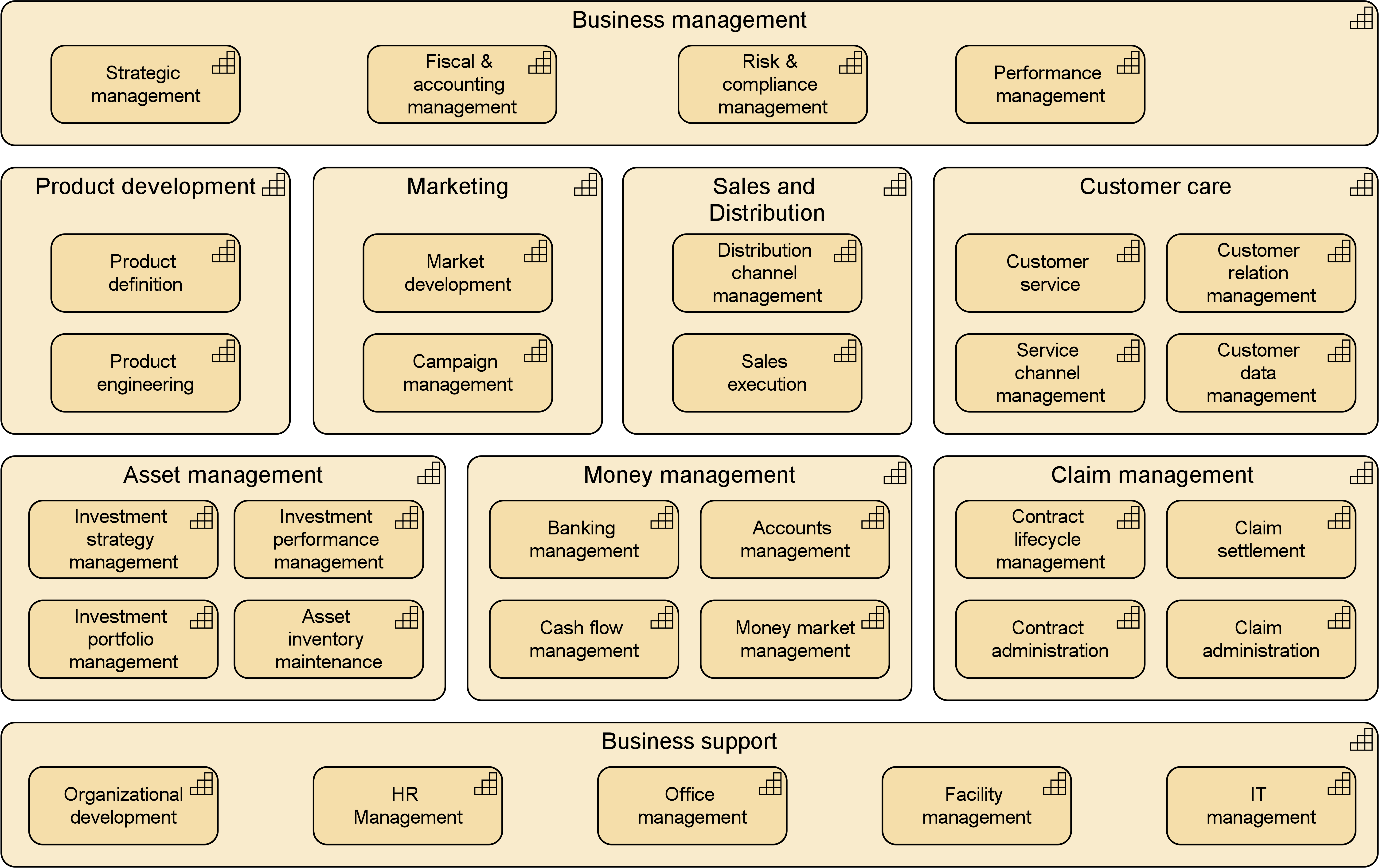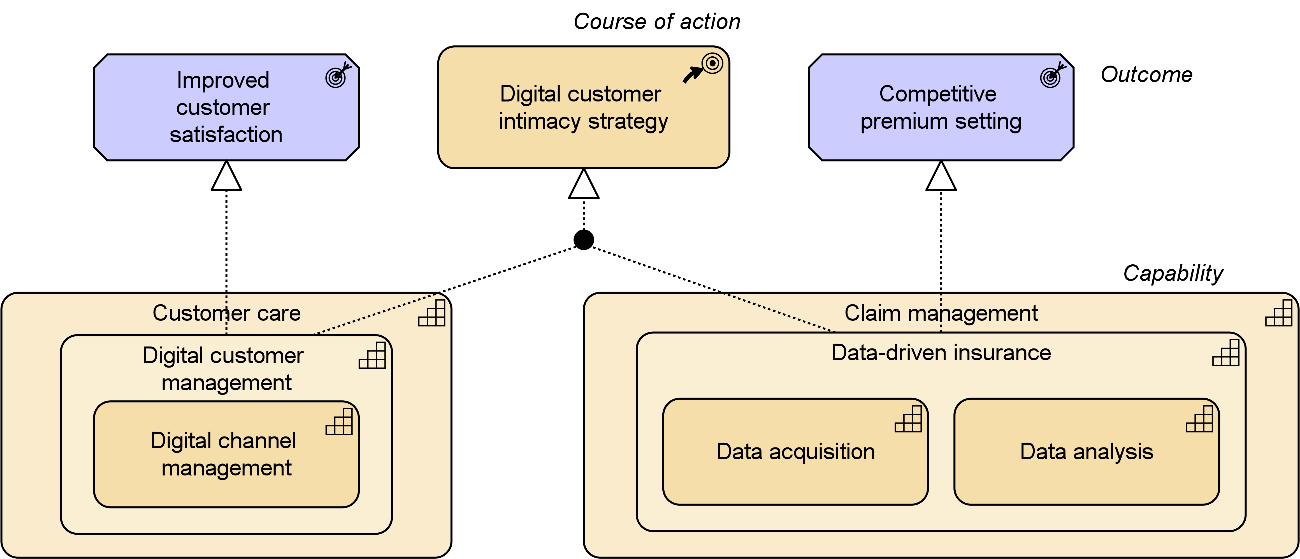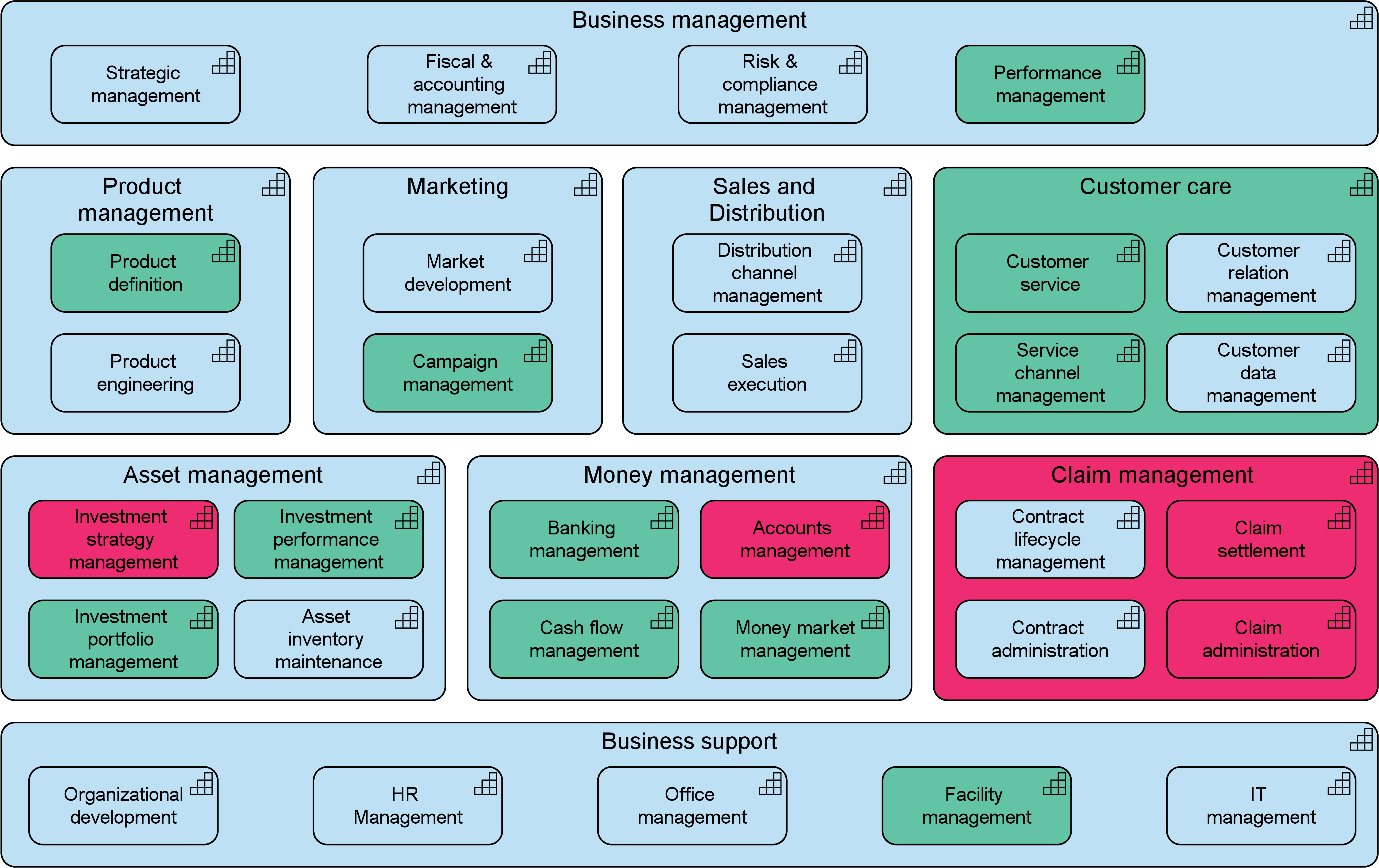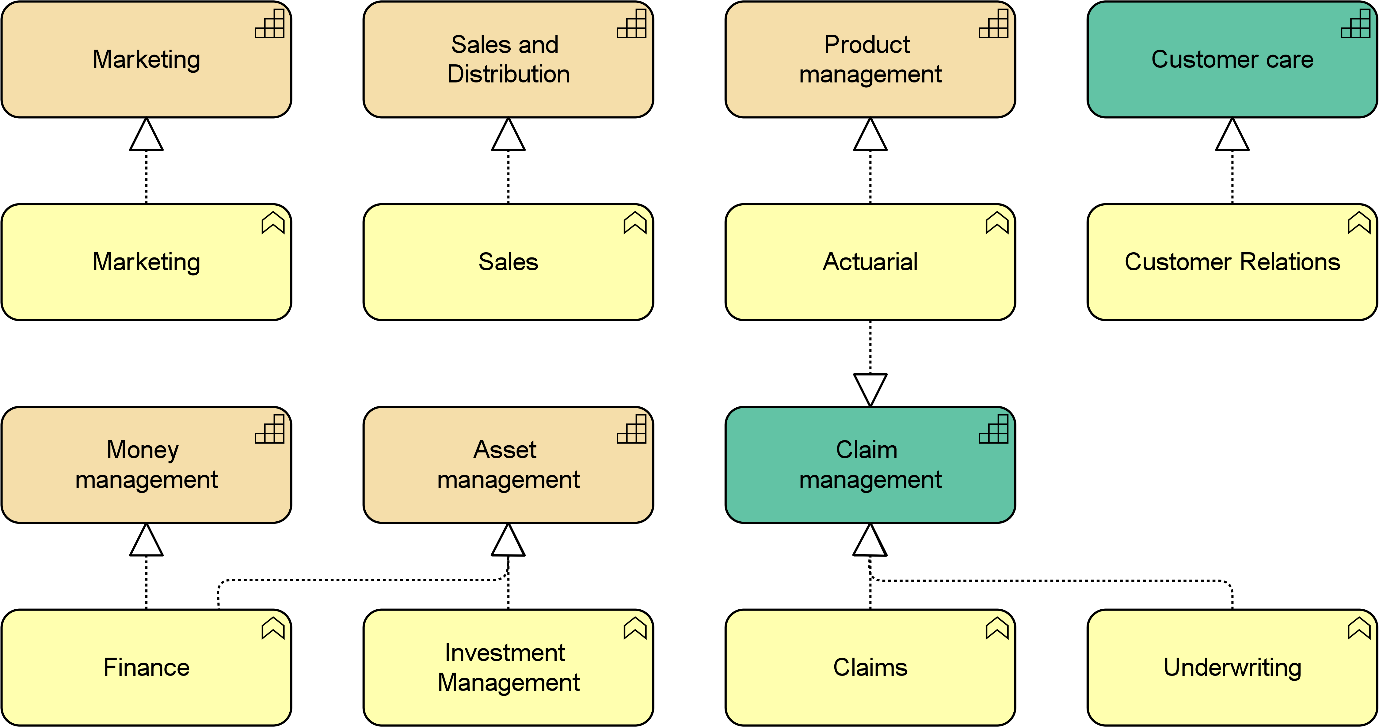Introduction
Capability-based planning is a growing practice in the field of enterprise architecture. Its success is due to the fact that it provides actual value to practitioners and the organizations that employs them. Indeed, capability-based planning helps in a number of ways, from providing a clear understanding of existing capabilities to promoting effective Business-IT alignment. Considering these benefits, we thought it useful to address this practice and bring some clarity to the subject for the benefit of all who might not yet have a good handle on the topic.
In order to do this, we take an applied approach whereby we explore a hypothetical but realistic scenario involving ArchiSurance, the fictitious insurance company used by The Open Group in the ArchiMate standard documentation (see also this whitepaper). Needless to say, we’ll be illustrating different aspects of capability-based planning in ArchiMate, the industry’s de facto standard language for EA modeling. So, without further ado, let us set the scene.
ArchiSurance is dealing with serious challenges. Ultra-low interest rates in the financial markets make it difficult to fulfill financial obligations for insurers, digital disruption is threatening their business models, and profit margins as well as market share are shrinking. How does ArchiSurance make enough money to survive in the short term and sustain the business in the long term? The company runs a strategic analysis of the main ways in which it can improve returns, depicted in Figure 1 below.

Figure 1: Strategic analysis
Based on this analysis, ArchiSurance identifies two different strategic options to address these issues. The first option is to maximize operational excellence by cutting costs, increasing self-service options, and streamlining and standardizing its product portfolio. ArchiSurance sees the rapid pace of technology innovation as both a challenge and an opportunity. This has led it to identify a second strategic option based on ‘digital customer intimacy’, which employs a combination of big data and the Internet of Things (IoT). According to this strategy, they intend to use detailed customer data to improve customer interaction and satisfaction, and to determine customized insurance premiums.
Next to this strategic analysis, it is also important to create a capability map of the organization in order to successfully transform the company. Figure 2 outlines the current capabilities of ArchiSurance, using the Capability concept introduced in ArchiMate 3.

Figure 2: Capability map
In its digital customer intimacy strategy, ArchiSurance takes a two-pronged approach. First, it wants to engage with its customers more intimately through various social media channels. Second, it aims to use real-time external data, e.g. from fitness trackers, to customize its insurance products.
Figure 3 below shows the main new capabilities needed to realize this strategy, how they relate to the current capabilities, and how they contribute to the business outcomes ArchiSurance wants to achieve. These strategy elements can also be linked to, for example, a higher-level description in the Business Model Canvas, where your capabilities may figure as key activities.

Figure 3: Digital customer intimacy strategy
Capability Mapping
So far, we have outlined the relationship between business strategy and capabilities at a high level. But we did not give you any guidance yet on how to create a good overview of your capabilities. Now as we move ahead, we look at why identifying capabilities is important for organizations, how you can define them, how to classify them, and how to include them in a capability map (an example of which you already saw in Figure 2).
Capabilities define what an organization needs to be able to do, to successfully achieve the outcomes that are defined as part of the corporate strategy. They are the key building blocks of the business, unique and independent from each other, and tend to be stable over time.
To help you define business capabilities, you may follow these general guidelines:
- Capabilities define what the business does or can do, not how it does it or who is doing it. They are different from business processes, functions, services, organization units, or IT systems, although these may all contribute to a capability. The same capability may be implemented in different ways, e.g. manually, IT-supported or fully automated.
- Capabilities are owned by the business and named and defined in business terms. Their definition should be readily understandable by all business professionals involved. Their names are nouns (e.g. ‘Product innovation’) as opposed to business processes, which are named with verbs (e.g. ‘Purchase materials’).
- Capabilities are unique and stable. They are defined only once for the whole enterprise and they rarely change, unless, for example, the enterprise undertakes a completely new line of business or divests part of its current business.
- Capabilities may be composite, consisting of sub-capabilities. A capability may also use other capabilities.
- Capabilities can be organized in a capability map, which provides an overview of the entire enterprise.
- A capability’s maturity can be assessed across different dimensions, such as people, process, technology, assets, or information. These are the basis for capability-based planning.
A capability map is a map of the enterprise that illustrates its capabilities in some state, e.g. current capabilities and their maturity level, or required capabilities in a future state. Each capability can be made more specific by decomposition. From a top-down perspective, capabilities are derived from the strategic direction of the organization.
From a bottom-up perspective, components and assets (e.g. applications, data, physical assets, but also knowledge and skills) can be linked to the capabilities they support, which creates an indirect link between these components and assets, on the one hand, and strategic direction, on the other. This way, you can use capabilities as a starting point for the definition of asset portfolios.
You can classify capabilities further, for example in:
- strategic vs. operational vs. supporting
- core vs. non-core
customer-facing vs. internal
- innovating vs. differentiating vs. commodity
Such a classification scheme highlights some interesting facts about investment and sourcing decisions, namely:
- Differentiating, customer-facing capabilities are core and are seldom outsourced.
- Strategic, innovating capabilities are important for the long-term future of an enterprise and are often assigned a separate budget to avoid the ‘innovation squeeze’, whereby the core, operational capabilities eat up all budget.
- Non-core, commodity or supporting capabilities are good candidates for outsourcing to partners that have these as their core, differentiating capabilities.
Let us take a look again at the Capability Map of ArchiSurance (Figure 4). The first thing to notice is that all capabilities in this capability map are named using nouns (e.g. “Product management”). Furthermore, there are seven main capabilities (e.g. “Claim management”, “Asset management” etc.), which have been decomposed into more specific capabilities (e.g. “Claim settlement”, “Contract administration” etc.), and their capability map is stratified into Strategic, Operational, and Supporting capabilities.

Figure 4: Capability map
The capability map is an essential tool that can be used by organizations to perform high-level performance assessments. As we move forward, we will address capability analysis, using heatmaps and spider charts, as well as capability realization.
Capability Analysis
Previously we have briefly outlined the two strategic options that our example insurance company ArchiSurance is exploring. By analyzing the operational excellence strategy, they have benchmarked their efficiency against the industry average: average capabilities are shown in blue, above-average capabilities in green and below-average capabilities in red (Figure 5). The capabilities which are shown in red is where ArchiSurance expects to find room for improvement in the context of the operational excellence strategy.
The example in Figure 6 shows how you can use spider charts to visualize your capability analysis in more detail. Each chart shows the current and desired performance of a capability along different axes. In Figure 6 we can see this notion of incremental development of a capability. For the ‘Claim management’ capability, we have defined six dimensions. The baseline analysis for this capability results in values for the different dimensions, which are linked using the red line. The required maturity, broken down into values for the individual dimensions, is indicated with the green line.
For the different dimensions of the capability analysis, we have defined a Metric concept as a specialization of Driver, using the language customization mechanism of ArchiMate. Metrics can be composite, as shown in the figure: the process dimension of the capability analysis consists of a weighted average of process adaptability, maturity, performance, and variance. Of course, you will want to define metrics in such a way that they support the strategic direction of your organization.

Figure 5: Capability heat map
Having the ability to define such metrics with ease is crucial. These can be based on externally imported data or on analyses of your models. For example, you can trace the importance of applications for your strategy via the processes they support, which contribute to the capabilities needed to deliver the envisaged business outcomes.

|

Figure 6: Capability Analysis
|
In a more general sense, capabilities prove to be a good starting point for capital allocation aligned with your organization’s strategy. Capability analyses may help you draw up investment plans, for example to allocate more budget to those capabilities that need a substantial improvement in one or more dimensions. They offer a coherent way for the business to address specific outcomes.
Capability Realization
The next step in ArchiSurance’s strategy implementation is the realization of these desired capabilities and capability levels. The company wants to establish several new capabilities to support its ‘Digital Customer Intimacy’ strategy, such as Digital Customer Management, Data-Driven Insurance, Data Acquisition, and Data Analysis. Figure 7 shows this in the context of current capabilities, using a ‘highlight’ function to emphasize these new elements.

Figure 7: New capabilities for the Digital Customer Intimacy strategy
Note that business functions are distinct from capabilities. Capabilities represent the current or desired abilities of an organization, realized by its people, processes, information, and technology. They are focused on specific business outcomes and are used for strategic planning purposes. In contrast, business functions describe the work actually done by the organization. They are often explicitly managed and are more closely aligned to the organization’s structure, often by assigning the responsibility for certain business functions to specific departments.
In describing the baseline business architecture, the value of a capability map mostly lies in the analysis of the current versus desired levels of capability, and in uncovering capabilities that the organization already possesses but does not recognize or manage explicitly. Capabilities and capability levels in a target business architecture give high-level direction for change. This is the core of capability-based planning. Of course, when you draw a map of the current capabilities of the organization, its current business functions will often figure prominently, since what you do today must by nature be something you are actually capable of doing. And multiple business functions may (together with other elements) contribute to the realization of a capability.
Figure 8 shows some of these relationships between several primary capabilities of ArchiSurance from the previous figure and its current business functions. The new sub-capabilities from the previous figure are part of the two green capabilities in this figure. These may be realized by augmenting the existing business functions (and the processes within them), but they might also need new functions and resources.
For instance, the ‘Data-driven insurance’ capability and its sub-capabilities may need an entirely new part of the organization to be set up, and the Actuarial, Claims and Underwriting business functions may be changed substantially.

Figure 8: Capability realization
These capabilities need the right resources including personnel with the right knowledge and skills for the digital age, smart devices for data acquisition, and the customer data itself. These resources themselves are realized by the enterprise architecture core.
Figure 9 shows a small part of what this may result in. Note that this does not depict all elements needed to realize these resources, but only a representative sample. In practice, you will often create separate views to show how individual capabilities and resources are realized.

Figure 9: Resources assigned to capabilities
By putting it all together, this provides a line of sight from your different assets upwards to the capabilities they support and to the strategies, goals and outcomes as outlined above. And you can even go further, e.g. linking detailed models of, say, your processes in BPMN or your data in UML, to your ArchiMate architecture model.
This way, you can gain insights into the effects of strategic decisions, and vice versa, uncover new options and innovations provided by the resources you employ. Planning, executing and controlling change across your enterprise has never been easier!
Note: All examples were realized in the BiZZdesign Enterprise Studio & HoriZZon suite.
Author: Marc Lankhorst, Chief Technology Evangelist & Managing Consultant at BiZZdesign,
Marc Lankhorst, Chief Technology Evangelist & Managing Consultant at BiZZdesign, is widely acknowledged as the “father of ArchiMate”, the de facto standard for modeling enterprise architecture. Marc has more than 20 years of experience as an enterprise architect, trainer, coach, and project manager. He has published extensively in the field of EA and is a regular speaker at conferences and seminars around the world.
BiZZdesign is a leading enterprise transformation software vendor based in the Netherlands. Founded in 2000 as the commercial spin-off of an R&D institute, today the company enjoys a global presence and is recognized by industry analysts as a market leader. BiZZdesign’s flagship product, Enterprise Studio, is deployed in blue chip companies and government organizations across all continents, where it plays a key role in enabling meaningful business change.